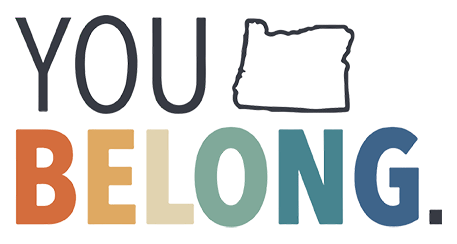Oregon is Leading the Fight Against Hate with the You Belong. Campaign
Click here to access our You Belong. campaign materials
Have you experienced or witnessed a hate crime or a bias incident?
A hate crime is a crime motivated in part or whole by bias against another person’s actual or perceived protected class–their race, color, disability, religion, national origin, sexual orientation, or gender identity. Examples include racist graffiti, stealing Pride flags, threats using slur words, assaulting someone based on their identity.
A bias incident is a non-criminal hostile expression motivated in part or whole by another person’s actual or perceived protected class, again meaning their race, color, disability, religion, national origin, sexual orientation, or gender identity. Examples include hate speech; using a racial, ethnic, or other slurs; displaying hateful symbols or flags; creating racist images/drawings; mocking someone with a disability; or telling or sharing offensive “jokes” about someone’s identity.
Click here for more information about the difference between a hate/bias crime and a bias incident.
Report and Support
Hate crimes and bias incidents are on the rise, both in Oregon and nationally. What’s happening is not ok. It is up to all Oregonians to make sure that everyone is safe in their community.
Oregon’s Bias Response Hotline is here to listen, support, and help.
Our “Report and Support System” is designed to support victims and help track hate crimes and bias incidents. We want to:
- Support survivors who have witnessed or been the target of hate crimes and bias incidents.
- Refer survivors to services that can help. We are not the police, and we do not report to the police without your permission.
- Inform Oregon’s legislature, governor, law enforcement, and community about the extent of the problem.
- Click here to learn more about what happens on the Hotline.
Why Should I Report?
While bias incidents and crimes sometimes target specific individuals, they often violate an entire group or community’s sense of safety and belonging. Graffiti on the wall, fliers, anonymous emails, and language meant to harass individuals convey intolerance that impacts all of us. We want Oregon to be welcoming and inclusive.
A History of Oregon’s Hate and Bias Laws
Oregon was the first state in the nation to pass hate crime laws. Click here to learn more about Oregon’s past and current hate/bias crime and bias incident laws.

